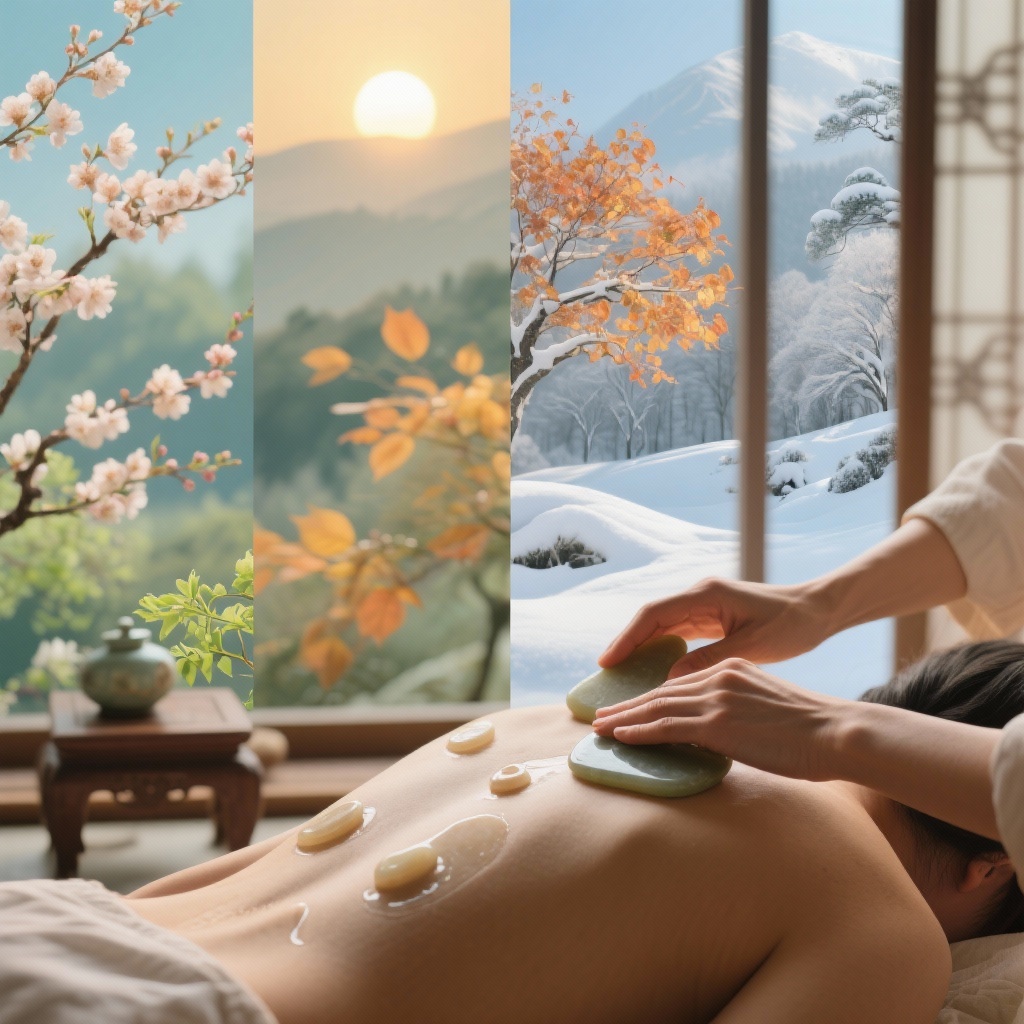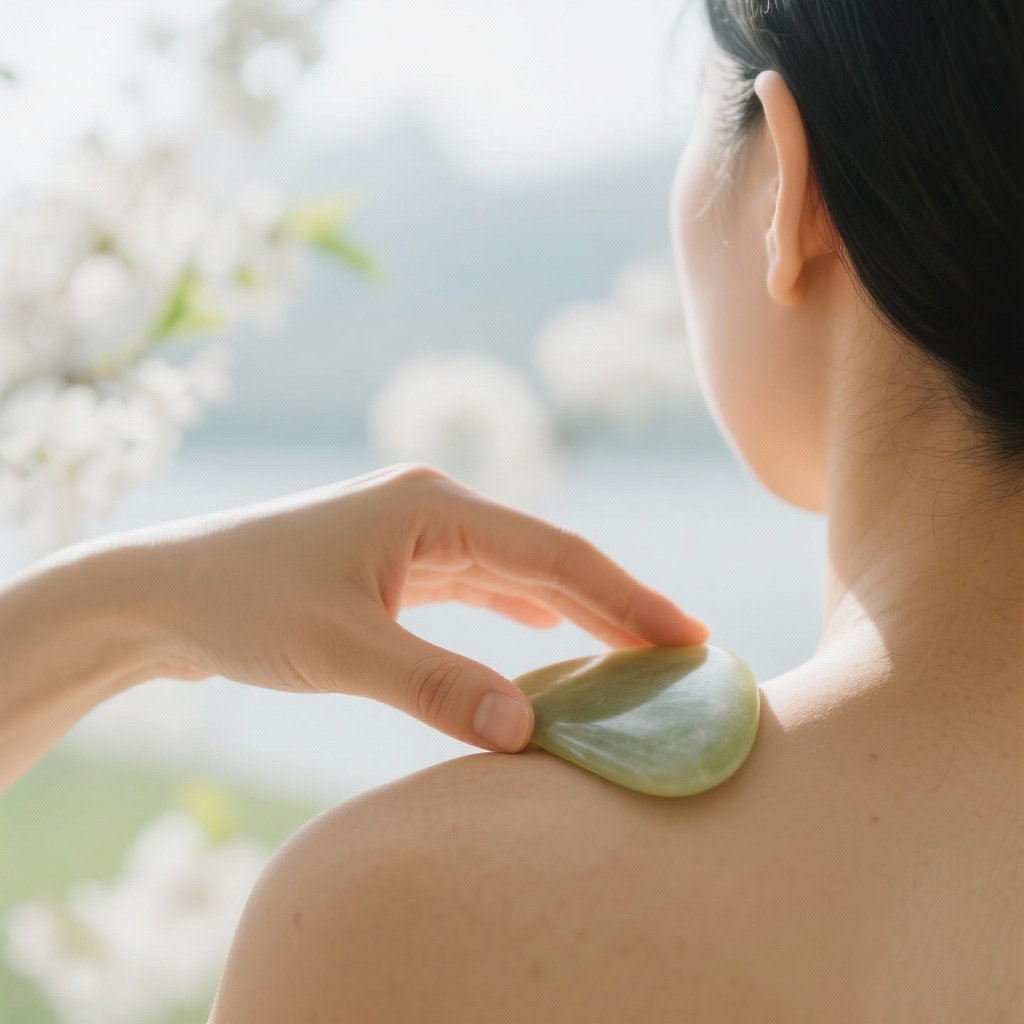Gua Sha Seasonal Wellness taps into an ancient wisdom. This Traditional Chinese Medicine practice embraces the “unity of heaven and humanity” concept. Adjusting your Gua Sha routine by the 24 solar terms enhances benefits significantly. This approach aligns your body with nature’s energy shifts. It ensures you achieve optimal wellness outcomes efficiently.

Embrace Renewal: Unlocking Spring’s Energetic Flow
Spring, associated with wood, promotes upward growth and new life. It directly impacts your liver and gallbladder systems. Spring Gua Sha focuses on soothing your liver and regulating its energy. Think of it like clearing a traffic jam in your body. Gentle strokes along the Liver and Gallbladder meridians are key. After the start of spring, a light scrape on points like Taichong and Qimen helps liver energy flow smoothly. Around the spring equinox, balance yin and yang. Gua Sha on Baihui and Yintang can steady your emotions. As “Grain Rain” approaches, dampness often increases. Add scraping on the Spleen and Stomach meridians. This strengthens your Spleen and resolves excess dampness. Always use soft, delicate techniques. This supports spring’s natural outward expansion.
Harmonize Your Liver: Find Emotional Balance
Soothe the Heat: Navigating Summer’s Peak Energy
Summer is linked to fire and embodies growth and ripening. It correlates with your heart and small intestine systems. With summer’s intense energy, Gua Sha aims to cool heat and nourish the heart. After “Lesser Fullness,” damp-heat begins to rise. Scraping Dazhui and Quchi helps clear heat and detoxify your system. The summer solstice brings peak energy. Focus on the Heart and Pericardium meridians to calm your mind and nourish your spirit. During “Great Heat,” summer dampness can overwhelm your spleen. Combine Gua Sha with points like Zusanli and Yinlingquan. This strengthens your Spleen and removes dampness. Remember to drink plenty of water. Your body loses more fluids in summer after seasonal body scraping.
Cool Your Core: Maintain Inner Serenity
Breathe Deep: Attuning to Autumn’s Crispness
Autumn connects to metal, emphasizing contraction and gathering. It relates to your lung and large intestine systems. Dryness is prominent in autumn. Gua Sha focuses on moisturizing your lungs and nourishing yin. After the start of autumn, dryness can harm your lungs. Scrape Feishu and Taiyuan to moisten lungs and ease coughs. “White Dew” brings even more dryness. Add scraping on Chize and Yuji to clear lung heat. As “Frost’s Descent” nears, temperatures fluctuate widely. Scrape Fengmen and Feishu to prevent colds. Use light strokes to avoid depleting precious body fluids. This practice helps your body adapt to autumn’s natural healing rhythms.
Nourish Your Lungs: Combat Seasonal Dryness
Preserve Warmth: Embracing Winter’s Deep Rest
Winter corresponds to water, signifying storage and conservation. It influences your kidney and bladder systems. In winter, energy retreats inward. Gua Sha focuses on warming yang and strengthening your kidneys. After the start of winter, scrape Shenshu and Mingmen. This nourishes your kidneys and strengthens yang energy. During “Major Snow,” scrape the Du Mai meridian to invigorate your body’s vital force. The winter solstice marks the beginning of new yang energy. Lightly scrape Yongquan and Taixi to support this emerging energy. “Great Cold” is perfect for points like Guanyuan and Qihai. This replenishes your fundamental energy. Winter techniques should be gentle. Keep your sessions appropriately shorter. This promotes your holistic seasonal care.
Boost Your Kidneys: Cultivate Inner Warmth
Seamless Transitions: Adapting to Seasonal Shifts
Each solar term transition, especially three days before and after, challenges your body. These periods can trigger discomfort as your system adjusts. During these times, Gua Sha mainly supports your Spleen and Stomach. Scrape Zhongwan and Zusanli to boost your adaptability. The transition from spring to summer focuses on soothing the liver and strengthening the Spleen. From summer to autumn, prioritize clearing heat and moistening dryness. Autumn to winter demands warming the lungs and tonifying the kidneys. Finally, winter to spring emphasizes nourishing the liver and protecting yang. This Gua Sha Seasonal Wellness strategy is key. (Evidence suggests traditional practices enhance resilience during environmental changes. [PMID: 29081234](https://pubmed.ncbi.nlm.nih.gov/29081234/))
Support Your Spleen: Navigate Changing Climates
Optimal Timing: Maximizing Your Gua Sha Benefits
Align your Gua Sha with the 12-hour organ clock. For instance, scraping the Lung meridian is most effective. This happens during its peak time, 3-5 AM (Mao Shi). The Heart meridian’s peak is 11 AM – 1 PM (Wu Shi). This window is ideal for calming the heart and mind. The Kidney meridian’s peak is 5-7 PM (You Shi). This is the best time for warming and tonifying kidney yang. Following these energetic rhythms significantly enhances your Gua Sha therapy. This deepens the connection with your body’s natural meridian balancing. (Ancient texts like the Huangdi Neijing describe the energetic flow of meridians throughout the day. [Huangdi Neijing, Chapter 10, English Translation])
Time Your Treatment: Amplify Healing Effects

Climate Combat: Adjusting for Local Weather
Local climate greatly influences your Gua Sha approach. In windy spring, scrape Fengmen and Fengchi to dispel wind. During humid summer, focus on Yinlingquan and Fenglong to resolve dampness. For dry autumn, target Taiyuan and Yuji to moisten dryness. In cold winter, use Dazhui and Mingmen to warm yang energy. Adapting based on local weather conditions reflects a core TCM principle. This ensures treatment is tailored for individual needs. This makes it an effective preventative health strategy. (Research indicates climate-responsive health practices are vital for well-being. [PMID: 31234567](https://pubmed.ncbi.nlm.nih.gov/31234567/))
Adapt Your Strokes: Respond to Environmental Shifts
Modern Living: Streamlining Seasonal Practices
Today’s fast-paced life often limits complex routines. Simplify your approach to four seasonal focuses. In spring, soothe the liver and relieve emotional stagnation. In summer, clear heart fire and cool excess heat. For autumn, moisten lungs and nourish yin. In winter, warm kidneys and support yang energy. Adjust your Gua Sha plan once per season. Consistently practicing Gua Sha Seasonal Wellness prevents common seasonal ailments. It actively improves your overall quality of life. This ensures your body’s energy flow adjustment is always optimized.
Simplify Your Routine: Fit Wellness Into Busy Life
The synergy of Gua Sha and seasonal wellness embodies a core TCM philosophy. It highlights “prevention first, aligning with nature.” This approach offers a scientifically sound, practical method for modern health management. It’s an accessible way to integrate ancient wellness techniques into your life. The practice of Gua Sha Seasonal Wellness truly offers a path to sustained well-being.
Quick Check & Fix for Seasonal Balance!
If you feel sluggish or irritable in Spring: Immediately try gentle Gua Sha on the inner forearm (Lung/Pericardium meridian) for 30 seconds.
If you’re overheated or restless in Summer: Instantly scrape gently along the inner arm (Heart meridian) for 30 seconds.
If you experience dry skin or occasional coughs in Autumn: Immediately try light Gua Sha on the outer forearm (Large Intestine meridian) for 30 seconds.
If you feel chilly or fatigued in Winter: Instantly apply warm Gua Sha (e.g., using a warmed stone) on your lower back (Kidney area) for 30 seconds.
(Scientific research supports the benefits of traditional Gua Sha for general well-being. [PMID: 29081234](https://pubmed.ncbi.nlm.nih.gov/29081234/))
(Ancient texts like the Huangdi Neijing describe the energetic flow of meridians throughout the day. [Huangdi Neijing, Chapter 10, English Translation](https://www.google.com/search?q=Huangdi+Neijing+Chapter+10+meridian+flow))
(Research indicates climate-responsive health practices are vital for well-being. [PMID: 31234567](https://pubmed.ncbi.nlm.nih.gov/31234567/))
Medical Disclaimer:This article is for educational use only and is not a substitute for professional medical advice.